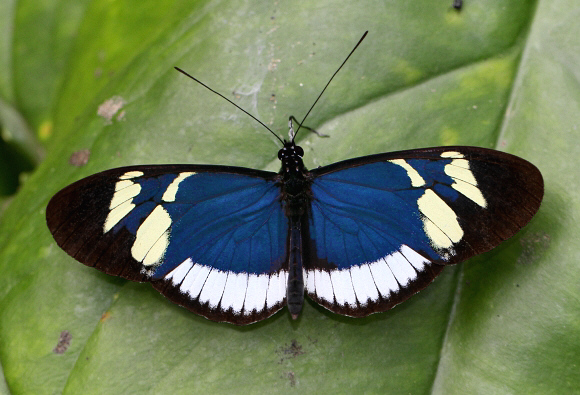![]() Heliconius cydno galanthus, Costa Rica – Maris Pukitis
Heliconius cydno galanthus, Costa Rica – Maris Pukitis
Introduction
The tribe Heliconiini, colloquially known as Longwings, includes 71 species, all confined exclusively to the neotropics. The Heliconiini includes the genera Heliconius, Podotricha, Dryas, Agraulis, Dione, Dryadula, Eueides, Neruda, Laparus and Philaethria.
The 39 Heliconius species are much studied by geneticists and taxonomists. Many of them produce a staggering variety of colour forms – Heliconius erato e.g. produces no less than 29 geographical forms, each of which corresponds almost exactly in colour and pattern to a “sister” subspecies of Heliconius melpomene flying in the same area.
All Heliconius species have elongated black wings, marked with simple but striking patterns usually featuring streaks or patches of red and cream, or blue and cream. A few, such as sara, antiochus and cydno have a metallic blue sheen over the basal area of both wings. All are characterised by their delicate fluttering flight, long straight antennae, and fondness for flowers.
There are 13 subspecies of cydno – distributed variously from Mexico to Colombia, Venezuela and Ecuador. In some subspecies such as weymeri and zelinde from Colombia the normally broad white band on the forewing is reduced in size or sometimes split into 2 distinct narrow bands resembling those of wallacei and sara. In hermogenes, also from Colombia, the band is broken up into a series of widely scattered small white spots. Most of the other races have a single broad white band as in galanthus, but have varying amounts of white on the hindwings.
![]() Heliconius cydno cydnides, Medellin, Colombia – Adrian Hoskins
Heliconius cydno cydnides, Medellin, Colombia – Adrian Hoskins
Habitats
The butterfly is found in forested areas at altitudes between sea level and about 2000m.
Lifecycle
To be completed.
Adult behaviour
Heliconius butterflies are characterised by having a very delicate fluttering flight, particularly when hovering around flowers. They commonly nectar at Hamelia, Lantana and Palicourea.
Unlike other butterflies, Heliconius females feed on pollen as well as nectar. Studies of ethilla have shown that females deprived of pollen can only produce about 15% of the number of eggs laid by females that have access to it. This probably applies equally to other Heliconius species including melpomene. The pollen from Psiguria, Anguria and Gurania flowers provides amino acids that can’t be obtained from nectar or other sources, and contributes greatly to the longevity of the butterflies – some Heliconius species are known to live for up to 9 months as adults.
Studies have shown that Heliconius butterflies have home ranges within which they can memorise the locations of nectar and pollen sources, host plants and communal roosting sites. They are able to plan the most efficient route by which to visit all nectar / pollen sources in the vicinity by using simple calculations akin to what mathematicians call the “travelling salesman algorithm”. Erlich & Gilbert demonstrated that individual butterflies memorise the location of particular Psiguria plants, which they visit daily, following a predefined circuit through the forest.
In the genus Heliconius most species rely entirely on airborne chemicals to locate mates. Males of hecale, ismenius and cydno are attracted by pheromones to the pupae of conspecific females. The day before emergence a female pupa will usually have several males in close attendance. A frantic battle takes place the instant she hatches, as the males all struggle to copulate with her, not even allowing her time to expand and dry her wings. In some other Heliconius species such as hecalesia, hewitsoni, erato, charithonia and sara the males don’t even wait until the female emerges. Instead they physically break open her pupa and copulate as soon as her genitalia are accessible.

Heliconius cydno cydnides, Medellin, Colombia – Adrian Hoskins
